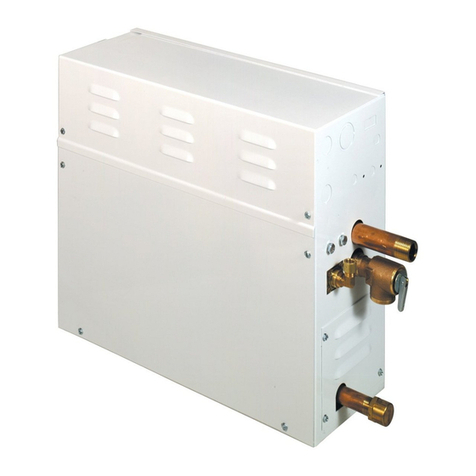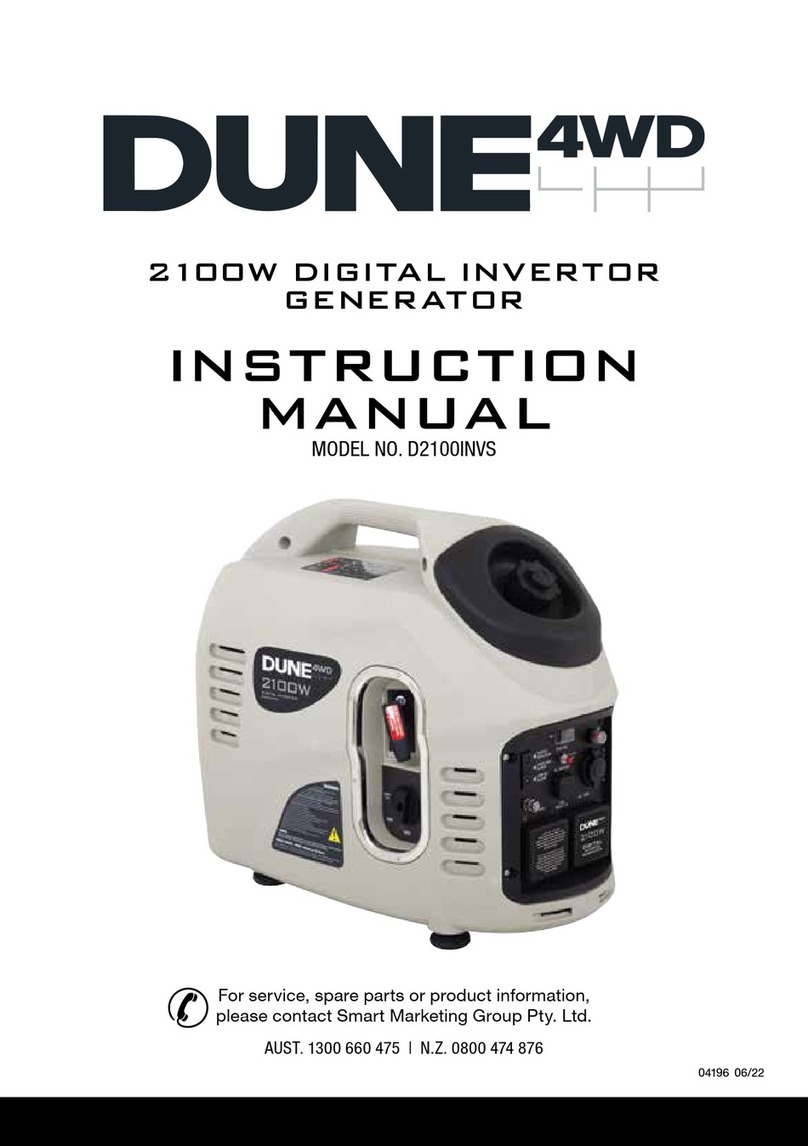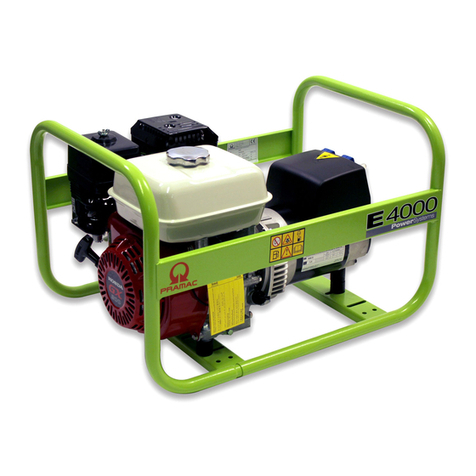WILDCAT POWER GEN FR0131240NG-LPG Setup guide

FR0131240NG-LPG
INSTALLATION AND OPERATORS MANUAL
DUAL-FUEL GENERATOR

WPG-FR013 V1.1 FR-OPMAN
2
SAVE THESE INSTRUCTIONS
This manual contains important instructions that
should be followed during installation and
maintenance of the generator and battery. Read
and understand all instructions in the manual
before starting and operating the generator set.
USING THE MANUAL
Congratulations on your choice of a WILDCAT
POWER GEN generator set. You have selected a
high-quality, precision engineered generator set
designed and tested to give you years of
satisfactory service.
To get the best performance from your new engine
generator set, it is important that you carefully read
and follow the operating instructions in this manual.
Should you experience a problem please follow
the “Troubleshooting Tables” near the end of this
manual. The warranty listed in the manual describes
what you can expect from Wildcat Power Gen should
you need service assistance in the future.
TABLE OF CONTENTS
INTRODUCTION 2
BASIC INFORMATION
Specifications 2
SAFETY INFORMATION 3
UNIT CAPABILITIES 4
PREPARING THE UNIT
Unpacking the Unit 5
LP/NG Installation 6
Fuel Line Sizing 6
Fuel Consumption 7
Fuel Pressure 7
Changing Fuel Types 8
Battery Installation 8
INITIAL START UP
Basic Operation 9
Electric Starting (LP/NG) 9
Stopping & Storage 10
Operating Speed 10
CONNECTING THE LOADS 11
Wiring 11
ENGINE CARE 12
GENERATOR CARE 13
TROUBLESHOOTING 15
WARRANTY INFORMATION 16
PROPER USE AND INSTALLATION
You must be sure your new engine generator set:
*
Properly serviced before starting.
*
Operated in a well-ventilated area.
*
Properly exhausted and gases
safely dispersed.
*
Operated only for its designed purposes.
*
Used only by operators who
understand its operation.
*
Properly maintained.
COPY YOUR MODEL AND
SERIAL NUMBER HERE
No other Wildcat Power Gen generator has the
same serial number as yours. It is important that
you record the number and other vital information
here. If you should ever need to contact us on this
unit it will help us to respond to your needs faster.
MODEL FR0131240NG-LPG
SERIAL NUMBER
PURCHASE DATE
DEALER
DEALER PHONE #
UNIT SPECIFICATIONS
GENERATOR MODEL FR0131240NG-LPG
Surge Watts 15,500
Continuous Watts 13,000
Volts 120/240
Amps 62.5
Engine Honda
GX690-VXC2
Generator Mecc Alte
S20F-230

WPG-FR013 V1.2 FR-OPMAN
3
SAFETY INFORMATION
This engine generator set has been designed and
manufactured to allow safe, reliable performance. Poor
maintenance, improper or careless use can result in
potentially deadly hazards, from electrical shock,
exhaust gas asphyxiation, or fire. Please read all safety
instructions carefully before installation or use. Keep
these instructions handy for future reference. Take
special note and follow all warnings on the unit labels
and in the manuals.
ANSI SAFETY DEFINITIONS
***************************************************************
DANGER:
DANGER indicates an imminently hazardous situation
which, if not avoided, will result in death or serious
injury. This signal word is to be limited to the most
extreme situations.
***************************************************************
***************************************************************
WARNING:
WARNING indicates a potentially hazardous situation
which, if not avoided, could result in death or serious
injury.
***************************************************************
***************************************************************
CAUTION:
CAUTION indicates a potentially hazardous situation
which, if not avoided, may result in minor or moderate
injury. It may also be used to alert against unsafe
practices.
***************************************************************
1.
ELECTRICAL SHOCK The output voltage
present in this equipment can cause fatal electric
shock. This equipment must be operated by a
responsible person.
a.
Do not allow anyone to operate the generator
without proper instruction.
b.
Guard against electric shock.
c
Avoid contact with live terminals or
receptacles.
d
Use extreme care if operating this unit in rain
or snow.
e. Use only three-pronged grounded receptacles
and extension cords.
f. Be sure the unit is properly grounded to an
external ground rod driven into the earth.
2.
FIRE HAZARD Gasoline and other fuels present a
hazard of possible explosion and/or fire.
a.
Do not refuel when the engine is running or
hot.
b.
Keep fuel containers out of reach of
children.
c.
Do not smoke or use open flame near the
generator set or fuel tank.
d.
Keep a fire extinguisher nearby and know
its proper use. Fire extinguishers rated ABC by
NFPA are appropriate.
e.
Store fuel only in an approved container,
and only in a well-ventilated area.
f.
Follow local codes for closeness to
combustible material.
3.
DEADLY EXHAUST GAS Exhaust fumes from
any gasoline engine contain carbon monoxide, an
invisible, odorless and deadly gas that must be mixed
with fresh air.
a.
Operate only in well ventilated areas.
b.
Never operate indoors including attached
garages
c.
Never operate the unit in such a way as
to allow exhaust gases to seep back into closed
rooms (i.e. through windows, walls, floors).
4.
NOISE HAZARD Excessive noise is not only
tiring, but continual exposure can lead to loss of
hearing.
a.
Use hearing protection when working
around this equipment for long periods of time.
b.
Keep your neighbors in mind when using
this equipment.
5.
CLEANLINESS Keep the generator and
surrounding area clean.
a.
Remove all grease, ice, snow or materials
that create slippery conditions around the unit.
b.
Remove any rags or other materials that
could create a potential fire hazard.
c.
Carefully clean up any gas or oil spills
before starting the unit.
6.
SERVICING EQUIPMENT All service, including the
installation or replacement of service parts, should be
performed only by a qualified technician.
a.
Use only factory approved repair parts.
b.
Do not work on this equipment when
fatigued.
c.
Never remove the protective guards,
covers, or receptacle panels while the engine is
running.
d.
Use extreme caution when working on
electrical components. High output voltage from
this equipment can cause serious injury or death.
e.
Always avoid hot mufflers, exhaust
manifolds, and engine parts. They can cause
severe burns instantly.
f.
The use of the engine-generator set must
comply with all national, state, and local codes.

WPG-FR013 V1.1 FR-OPMAN
4
TESTING POLICY
Before any generator is shipped from the factory, it
is fully checked for performance. The generator is
loaded to its full capacity, and the voltage, current
and frequency are carefully checked.
Rated output of generator is based on engineering
tests of typical units, and is subject to, and limited
by, the temperature, altitude, fuel, and other
conditions specified by the manufacturer of the
applicable engines.
INTENDED USES
This engine generator set has been designed
primarily for stationary heavy duty remote use. Both
120-volt and 240-volt receptacles are provided in
the control panel to plug in your loads (lights,
portable tools, and small appliances). These units
are dual wound generators, therefore the 120-volt
loads must be equally split with 1/2 of the rated
capacity avail- able on each of the two 120 volt
circuits.
This stationary unit requires large quantities of
fresh air for cooling the engine and generator. For
safety, long life and adequate performance, these
units should never be run in small compartments
without positive fresh air flow.
RESTRICTED USES
DO NOT remove from the cradle assembly.
Removal of the generator from the cradle
assembly may cause excessive vibration and
damage to the engine-generator set.
DO NOT install and operate this generator in a small
compartment., i.e. generator compartments of
vehicles, motor homes or travel trailers. These
compartments will not allow enough free flow of
fresh air to reach the engine generator set for
cooling and will cause the unit to overheat,
damaging both the engine and generator. Small
compartments will also develop hot spots where
there is very little air flow and may cause a fire.
PLEASE NOTE There are 3rd party companies
making enclosures for generators that have been
properly engineered. The use of these 3rd party
enclosures is acceptable as long as they have been
certified and meet current code.
DO NOT attempt to operate at 50 cycles
equipment. These units are designed and
governed to operate at 60 cycles only.
UNIT CAPABILITIES
GENERATOR CONNECTIONS
FR0131240NG-LPG: 120 volt and 240-volt
receptacles are provided for connection to various
loads. The diagram below represents this 13,000 watt
(rated output) generator. A & B represent the 120 volt
out-put legs of this generator. Up to 4000 watts at 120
volts (33 Amps) can be drawn from the receptacles
attached to either A or B output legs. This generator is
capable of producing 62.5 Amps of 240-volt current at
C. Check the appliance or tool nameplates for the
current and voltage to insure compatibility. Remember
that power taken from C reduces the power available
at equally both A and B and vice versa.
STARTING ELECTRIC MOTORS
Electric motors require much more current (amps) to
start them than to run them. Some motors, particularly
low-cost split-phase motors, are very hard to start and
require 5 to 7 times as much starting current as running
current. Capacitor motors are easier to start and usually
require 2 to 4 times as much starting current as running
current. Repulsion Induction motors are the easiest to
start and require only 1 1/2 to 2 1/2 times as much
starting as running current.
Most fractional horsepower motors take about the
same amount of current to run them whether they are
Repulsion Induction (RI), Capacitor (Cap), or Split-
Phase (SP) type.
If the electric motor is connected to a hard starting
load such as an air compressor, it will require more
starting current. If it is connected to a light load,
or no load such as a power saw, it will require
less starting current. The exact requirement will
also vary with the brand or design of the motor.

WPG-FR013 V1.2 FR-OPMAN
5
Self-exciting generators respond to severe overloading
differently than utility power. When overloaded, the
engine is not able to supply enough power to bring the
electric motor up to operating speed. The generator
responds with high initial starting current, but the
engine speed drops sharply. The overload may stall
the engine. If allowed to operate at very low speeds,
the electric motor starting winding will burn out in a
short time. The generator winding might also be
damaged.
CAUTION: EQUIPMENT DAMAGE
RUNNING THE GENERATOR SET UNDER THESE
CONDITIONS MAY RESULT IN DAMAGE TO THE
GENERATOR STATOR AS WELL AS THE MOTOR
WINDING.
The heavy surge of current required for starting
motors is required for only an instant. The genera- tor
will not be damaged if it can bring the motor up to
speed in a few seconds of time. If difficulty is
experienced in starting motors, turn all other electrical
loads off and if possible, reduce the load on the
electric motor.
PREPARING THE UNIT
UNPACKING
CAUTION: EQUIPMENT DAMAGE
THIS UNIT HAS BEEN SHIPPED WITH OIL.
Failure to maintain the engine oil at the proper level will
result in serious engine damage.
When you unpack your new engine-generator set be
sure to remove all the information sheets and manuals
from the carton.
1.
This generator-set was in good order when
shipped. Inspect the generator-set promptly after
receiving it. If any damage is noted, notify the
transportation company immediately; request proper
procedures for filing a “concealed damage” claim. Title
to the equipment and responsibility for filing a claim
rests with you when a generator-set is sent F.O.B.
shipping point. Only you can legally file a claim.
2.
Before proceeding with the preparations of your
new generator-set for operation, take a couple of
minutes to ensure the unit you have received is the
correct model and review the specification pages in
this manual to insure that this unit meets your job
requirements.
LUBRICATION
Before starting the engine, fill the crankcase to the
proper level with a good quality oil. The recommended
grade of oil and quantity of oil required is listed in the
engine operator’s manual and under the service tab in
this manual. This unit was shipped with most of the oil
removed. The engine normally holds 46 to 48 ounces
of oil. Since there is some trapped oil in the engine,
when filling the crankcase, the first time use the
dipstick (ref “A”) to ensure that you do not over fill the
crankcase. Reference “B” shows the full oil level mark
on the dipstick.
Oil is added to the engine by removing the oil fill cap
and adding oil at this point. After filling the crankcase
to the proper level, be sure you properly tighten the oil
fill cap. NOTE: This engine generator must be on a
level surface before you check or add oil to the
system.
The necessity of using the correct oil and keeping the
crankcase full cannot be overemphasized. Engine
failures resulting from inadequate or improper lubricant
are considered abuse and not covered by the generator
or engine manufacturer’s warranty.
Oil Recommendations
Outdoor temperatures determine the proper oil
viscosity for the engines. Use the chart to select the
best viscosity for the outdoor temperature range
expected.

WPG-FR013 V1.1 FR-OPMAN
6
Oil Recommendations Con’t
* Below 40OF (4OC) the use of SAE30 will result in hard
starting.
** Above 80OF (27OC) the use of 10W-30 may cause
increased oil consumption. Check oil level more
frequently.
Engine OEM recommends the use of their warranty
certified oils for best performance. Other high- quality
detergent oils are acceptable if classified for service SF,
SG, SH SJ or higher. Do not use special additives.
LP/NG FUEL INSTALLATION
The information in this instruction is offered to assist
you in providing the proper vapor fuel supply for your
engine. This information is only provided to advise you
of the engine’s requirements and the decisions you
must make. In no case should this information be
interpreted to conflict with any local, state or national
code. If in doubt, always follow local codes.
DANGER: FIRE - PERSONAL INJURY -
All fuel lines must be installed by a qualified fuel
supplier.
The fuel source should be as close as possible to the
outdoor operating location. This will reduce the
installation cost of fuel runs. Connect the fuel supply
line to the inlet of the fuel demand regulator on the unit
using a locally approved flexible fuel line (see table for
recommended line size). *WARNING: CONNECT TO
THE LARGE ¾” NPT PORT ON THE REGULATOR
LOCK OFF VALVE. NOT THE SMALL 1/8” NPT
PRESSURE TESTING PORT.* The pressure
supplied to the demand regulator must be FOUR
TO SIX OUNCES or 7 to 11 INCHES W.C. (water
column). The primary regulator at the fuel supply
must be capable of delivering the proper volume
of fuel at this pressure.
Have your local fuel supplier install a protected fuel
connection at the outside operating location. He should
also install a lockable fuel shut off valve at the
connection point. Have your fuel supplier permanently
install a flexible fuel line to the demand regulator on the
engine generator set.
DANGER: FIRE - PERSONAL INJURY -
The LP/NG fuel supply line must always be shut off
when the engine is not running. Failure to do so may
allow fuel to leak at the unit.
INSTALLING THE FUEL LINE
DANGER: PERSONAL INJURY
Units that are intended to be run unattended MUST
have an electric fuel solenoid installed. This solenoid
MUST be wired to AUTOMATICALLY turn off the fuel
whenever the engine stops.
Unit location will determine the size of fuel line that is
required to supply the engine with a constant fuel
pressure. Refer to the tables below for fuel line size,
and recommended tank size. For distances of 100
feet and over, a two-regulator fuel system is
recommended. This system consisting of a primary
10-15# regulator at the tank and a 6-ounce secondary
regulator installed about 10 feet from the generator.
You need to run a 1/2-inch line or larger from the
secondary regulator to the engine-generator set.
When a two (2) regulator fuel system is used, a fuel
line size of 3/8 inch is generally adequate for
distances up to 300 feet. The line size from the table
below applies to the distance from the second
regulator to the demand regulator. A positive fuel
shut-off device must be installed in the fuel line
close to the engine generator set. This may be
either a lockable manual shut-off valve available from
your local fuel installer, or a 12-volt DC fuel solenoid
valve. This 12-volt DC valve is available through your
local WILDCAT POWER GEN dealer.
The fuel line used to connect the supply line to the
demand regulator must be a locally approved flexible
fuel line. Products used will vary in different regions
depending on availability and local codes. Consult
with your local fuel supplier to ensure complete
compliance with ALL codes.
1. Remove the pipe plug from the demand regulator.
2. Connect the flex fuel line to the demand regulator
to the optional fuel solenoid.
DANGER: PERSONAL INJURY
°F
°C

WPG-FR013 V1.2 FR-OPMAN
7
Do not use galvanized pipe in the fuel line runs.
The galvanized coating will become eroded and flake
off, causing possible obstruction or damage to the
regulator or fuel valve. The obstruction could cause an
inoperative engine or an explosive fuel leak.
Size of pipe required for generators operating on
natural gas/LP gas.
Length of Fuel Line* Fuel Line Size less than 25
feet: 3/4-inch black pipe
25 to 100 feet: 1-inch black pipe
over 100 feet not recommended**
*allow an additional 3 feet for each standard elbow. Do
not use ‘street ells’ (restrictive)
** Consult factory for fuel runs over 100 feet.
DANGER! - FIRE - PERSONAL INJURY -
Be careful when sealing gas joints. Excessive sealing
compound can be drawn into the solenoid, regulator or
carburetor causing an engine malfunction or dangerous
fuel leak.
FUEL CONSUMPTION (Full Load)
FUEL PRESSURE
Correct fuel pressure cannot be stressed enough.
The most common cause for inoperative systems is
an inadequate or incorrect fuel pressure. Power and
performance of the engine is in direct relation to the
correctness of the fuel system. Shown below is a
block diagram of a typical L.P. or N.G. installation.
Reference numbers 1 through 3 in the block
diagrams above are system parts supplied by
customer.
Reference number 4 is the engine generator set.
Below is a table of the fuel pressure reading at each
reference in the system.
Fuel Pressure Table
Single Regulator (L.P. Vapor only)
1
3
4
UNIT OFF TANKPSI 7-11 in 7-11 in
4-6 oz 4-6 oz
STARTING TANK PSI 7-11 in 7-11 in
4-6 oz 4-6 oz
NO LOAD TANK PSI 7-11 in 7-11 in
4-6 oz 4-6 oz
FULL LOAD TANK PSI 7-11 in 7-11 in
4-6 oz 4-6 oz
LP Vapor
1.9 Gal/HR
173,850 BTU
Natural Gas
180 cu ft/hr
180,000 BTU

WPG-FR013 V1.1 FR-OPMAN
8
Natural Gas
1
3
4
UNIT OFF LINE PSI
7-11 in 7-11 in
4-6 oz 4-6 oz
STARTING LINE PSI
7-11 in 7-11 in
4-6 oz 4-6 oz
NO LOAD LINE PSI
7-11 in 7-11 in
4-6 oz 4-6 oz
FULL LOAD LINE PSI
7-11 in 7-11 in
4-6 oz 4-6 oz
Remember that whichever fuel delivery system or type
of vapor fuel used, the fuel pressure at the demand
regulator installed on the engine generator must be
between 4 and 6 oz. (7-11 inches of water column).
Any lower pressure and the unit will starve for fuel
under load. Any higher and the unit will ‘flood’ when
attempting to start.
LP TANK SIZING
Once above the minimum acceptable size, the size of
L.P. tank used will generally depend on how long you
want the unit to run without refilling. The tank sizes
shown below are the smallest recommended tank
sizes based on the outside temperature. Keep in mind
the colder it gets the slower L.P. will vaporize. This is
the reason for the larger tanks at low temperature.
Minimum sizing is not based on running time.
CHANGING FUEL TYPES
These engine generator sets are designed to run on
two different fuels; natural gas or LP vapor. They are
set from the factory for LP. Changing from LP to NG
can be easily performed. Please contact your dealer or
Wildcat Power Gen for instructions and kit.
BATTERY INSTALLATION
This engine generator set is shipped with a battery
tie down kit for customer installation. This kit
consists of a battery tie down and hardware for
installation of the customer supplied battery on the
unit. If you intend
to use the power plant’s electric start system, you
will need to purchase and install a battery to operate
it. Units equipped with a recoil or rope start will
operate satisfactorily on gasoline without a battery
but stating on LP/NG requires electric start be used.
WARNING: EQUIPMENT DAMAGE
The battery positive (+) cable is shipped with a
plastic protective cap. When starting manually, this
protective cap must remain in place to avoid
possible damage to the engine electrical system
and/or generator end.
A 12-volt powersports
(motorcycle/ATV/snowmobile) battery, BCI group
20 or 24HL rated at 300 CCA or larger is
recommended for this electric start engine generator
set. Maximum length: 8 1/8”, Maximum width: 3
9/16”, Height range: 5 3/4” - 7”.
Amp Hours: 35AH or greater. Follow the battery
manufacturers recommendations for servicing and
charging prior to use. Connect the battery to the
electric start system using the cables provided.
CAUTION: EQUIPMENT DAMAGE
These electric start engines are NEGATIVE
GROUND. Use extreme caution when connecting
the battery. Connect the NEGATIVE battery terminal
to GROUND.
For your safety always connect the positive battery
Temp f. 60 deg 30 deg 0 deg -20 deg
150 gal 250 gal 500 gal
1000 gal

WPG-FR013 V1.2 FR-OPMAN
9
cable to the “bat+” terminal first. Then connect the
negative battery cable to the “bat-” terminal. Make
sure all connections are clean and tight. Reverse the
sequence when disconnecting, disconnect the
negative cable first. These engines produce enough
direct current to keep a battery charged under normal
operating conditions but were not intended to be used
as a battery charger.
WARNING: PERSONAL INJURY
Lead acid batteries produce explosive hydro-
gen gas when charging. Keep sparks, flames, and
burning cigarettes away from the battery. Ventilate
the area when charging or using the battery in an
enclosed space. Lead acid batteries contain sulfuric
acid, which causes severe burns. If acid contacts
eyes, skin or clothing, flush well with water. For con-
tact with eyes, get immediate medical attention.
BATTERY CHARGING
Units equipped with electric start have a small fly-
wheel charger built into the engine flywheel assembly
for recharging the starting battery. This flywheel char-
ger generates a small AC current that passes through
a diode assembly to produce a DC charging current
of about 1 to 3 AMPS. This circuit is not designed to
be used as a battery charging circuit to recharge dead
batteries.
OIL ALERT SYSTEM
This WILDCAT POWER GEN generator is equipped
standard with low oil shutdown systems. The Honda
engine uses an oil pressure switch system. This low
oil warning system will automatically stop the engine
before the oil level reaches a critical danger point.
This feature is designed to prevent costly repairs
and downtime. CAUTION: EQUIPMENT DAMAGE
Allowing the engine to shutdown repeatedly on low oil
level may cause excessive wear which can be
cumulative.
INITIAL START UP
The throttle control on these generators is preset and
locked to operate at 3600 RPM (nominal) with no load
speed set at 3690 RPM. Only a trained service
technician should be allowed to adjust this speed
setting.
NOTICE: ENGINE START LOCKOUT
This unit will not start if it is low on oil. The
lubricating oil level must be at the full mark before
the engine will start and run.
BASIC OPERATION
ELECTRIC STARTING (LP/NG only)
When operating on LP or NG, you will have to
always use the electric start to get the unit running.
Because of the engine vacuum need to activate the
fuel system it is almost impossible to manual start
the unit using LP or NG.
1.
Check oil level. Refill as needed
2.
Turn on the LP/NG fuel supply
3.
Push the On/Off switch.
On/Off Switch
Run

WPG-FR013 V1.1 FR-OPMAN
10
4.
Press the “Run” button. The generator will begin
its start cycle. The starter life is improved by
using shorter starting cycles with time to cool off
between cranking cycles. Do not operate the
starter more than 15 seconds during each minute.
Repeat if necessary.
5.
The engine should promptly come up to operating
speed.
PLEASE NOTE: After 30 seconds, the controller’s
front panel will go off. The LED light on the On/Off
switch will stay lite while there is power to the unit.
After 30 seconds, the controller’s front panel will turn
off. THE UNIT IS IN SLEEP MODE. IF EQUIPPED
WITH A 2-WIRE START CAN START
AUTOMATICALLY.
STARTING HINTS
1.
Cold weather
a.
Use the proper oil for the temperature
expected.
b.
Battery capacity will be less.
Assure voltage of 11V or higher.
2.
Hot weather
a.
Use the proper oil for the temperature
expected.
STOPPING AND STORAGE
1.
Press the “Stop” button.
2.
If not equipped with 2-Wire Start, move the on/off
switch to the “OFF” position.
3.
Before extended storage (over 30 days) certain
precautions must be taken to ensure the fuel does
not deteriorate and clog the fuel system.
Note: Running the engine to use up the fuel in the
lines and carburetor will still leave a small amount of
fuel in the carburetor. It is best for extended storage
to treat the fuel before draining.
a.
While the engine is warm, drain the oil and refill
with fresh oil.
b.
Clean dirt and chaff from cylinder, cylinder head
fins, blower housing, screen.
c.
Remove and clean muffler spark arrester.
d.
Store in a clean and dry area.
OPERATING SPEED
The engine-generator must be run at the correct
speed in order to produce the proper electrical
voltage and frequency.
CAUTION: EQUIPMENT DAMAGE
The output voltage should be checked to ensure the
generator is working properly prior to connecting a
load to the generator. Failure to do so could result
in damage to equipment plugged into the unit and
possible injury to the individual.
All engines tend to slow down when a load is
applied. When the electrical load is connected to
the generator, the engine is more heavily loaded,
and as a result the speed drops slightly. This slight
decrease in speed, together with the voltage drop
within the generator itself, results in a slightly lower
voltage when the generator is loaded to its full
capacity than when running no load. The slight
variation in speed also affects the frequency of the
output current. This frequency variation has no
appreciable effect in the operation of motors, lights
and most appliances. However, electronic
equipment and clocks will be affected if correct
RPM is not maintained. See Load vs. Output chart.
Although individual units and models vary slightly,
the normal voltage and frequency of the engine-
genera- tor described in this manual are
approximately as follows, under varying loads:
LOAD VS. OUTPUT
Generator
Load
Speed
(RPM)
Frequency
(Hz)
Voltage
None
3690
61.5 125V
Half
3600
60.0 120V
Full
3510
58.5 115V
The speed of the engine was carefully adjusted at
the factory so that the generator produces the
proper voltage and frequency. For normal usage,
the speed setting should not be changed. If the
generator is being run continuously on a very light
load, it is often advisable to lower the operating
speed slightly.
STOP

WPG-FR013 V1.2 FR-OPMAN
11
CAUTION: EQUIPMENT DAMAGE
SPEED ADJUSTMENTS SHOULD ONLY BE MADE
BY A QUALIFIED SERVICE TECH.
Whenever making any speed adjustments, check
the unit with a voltmeter and a frequency meter or
tachometer and be sure the voltage and speed are
correct.
Lower voltage may damage both the generator and any
load connected to it. Running the engine at excessively
high speeds results in high voltage, which may
significantly shorten the life of appliances being used.
Output voltage should be checked periodically to
ensure continued proper operation of the generating
plant and appliances. If the generator is not equipped
with a voltmeter, it can be checked with a portable
meter.
CONNECTING THE LOADS
APPLYING THE LOADS
Allow the engine to warm up for two or three minutes
before applying any load. This will allow the engine to
reach normal operating temperature and oil to
circulate throughout the engine. A short warm-up time
will permit the engine to work more efficiently when
the load is applied and will reduce the wear in the
engine, extending its life.
Receptacles have been provided to allow loads to be
connected to the generator. The loads should be
added one at a time. If a large motor is being started;
or multiple motors are being started, they should be
started individually and the largest should be started
first.
CAUTION: EQUIPMENT OVERLOAD
Keep the generator load within the generator and
receptacle nameplate rating. Overloading may cause
damage to the generator and/or the loads.
Most electric tools and appliances will have the volt-
age and amperage requirements on their individual
nameplates. When in doubt, consult the manufacturer
or a local electrician. The nameplate amperage rating
for electric motors can be misleading. See “Starting
Electric Motors” in Unit Capabilities (page 4).
These engine-generator sets are inherently self-
regulating based on engine speed. The engine
governor will automatically adjust itself to the load.
No harm to the generator will result if it is operated
with no load connected. Proper utilization of the
receptacles located on the control panel is
necessary to prevent damage to either the
receptacles or the generator.
The generator is a limited source of electrical
power, therefore, pay special attention to the
receptacle and generator ratings. The nameplate
rating can be obtained through a single receptacle
as long as the receptacle amperage rating is not
exceeded.
GROUNDING
All units must be grounded. Drive a 3/4 or 1” copper
pipe or rod into the ground close to the engine-
generator set. The pipe must penetrate moist earth.
Connect an approved ground clamp to the pipe.
Run a no. 10 AWG wire from clamp to the generator
ground lug on the receptacle panel. Do not connect
to a water pipe or to a ground used by a radio
system.
The engine-generators covered in this manual were
designed primarily for portable use. If you are
connecting into a building wiring system that is
already grounded using the 14-60 4-wire plug, you
do not have to ground the unit.
WARNING: PERSONAL DANGER
DO NOT OPERATE THIS GENERATOR
INDOORS.
The unit should be stored in a warm dry location.
During a power outage, move the unit outdoors to a
flat dry location such as a driveway or sidewalk.
WIRING
Plug your tools such as drills, saws, blowers, sump
pump and other items to be powered directly into
the generator receptacles. Before plugging in all the
tools and cord sets, recheck the rating of the
generator set. Be sure it can handle the intended
load and is compatible with the voltage, phase, and
current ratings. ‘Hard Wiring’ this unit directly into a
home or a temporary construction site electrical
system is NOT A SIMPLE DO-IT-YOURSELF JOB.
For your safety, all wiring must be done by a
qualified electrician and conform to the National
Electric Code and comply with all state and local
codes and regulations. Check with local authorities
before proceeding.
WARNING: PERSONAL DANGER
A fully isolated, double pole double throw manual
transfer switch must be installed any time a
generator is being connected to an existing
distribution system.

WPG-FR013 V1.1 FR-OPMAN
12
1. These engine generator sets are designed for
portable use. Receptacles are provided on the control
panel to permit 120-volt portable appliances and tools
to be plugged directly into them. Please note that the
4-wire 120/240-volt receptacle on these units are
designed to power both 120 or 240 volt loads. The plug
for this receptacle can be wired for either 120-volt,
2. 240-volt, or a combination of 120 and 240-volt
loads depending on how the plug is wired.
A 4-wire receptacle (two hot, one ground, and one
neutral) has been provided on the control panel for use
in temporary power applications requiring 120/240-volt
power. Consult a licensed electrician for wiring the
temp power plug and connecting it as temporary
service. To connect these units directly to an un-
powered, isolated construction site Temp-Power panel,
have your electrician connect to the control panel using
a 120/240 volt, 4-wire twist-lock plug (L14-30P).
3. If the generator set is be connected to an existing
distribution system, a fully isolated manual transfer
switch must be installed. The transfer switch prevents
damage to the generator and other circuit components
if main line power is restored while the generator is
connected. Installing a transfer switch also permits the
use of normal fusing.
4. Many homes and construction sites are wired for
at least 60 to 100 Amp entrance service, much
greater than the capacity of this portable genera- tor.
When installing the generator at these sites, a
secondary emergency distribution panel may
have to be installed, such as the Emergency Trans-
fer/Service (ET/S) system available through your
WILDCAT POWER GEN dealer. The emergency
distribution panel must be installed by a licensed
electrician according to all applicable codes. The
electrician will move the critical circuits to be powered
during the outage to the emergency panel. Keep in
mind only a limited amount of amperage is available
from the genera- tor set. Some circuit breakers may
still have to be turned off to prevent an overload on the
generator during the initial startup. See the nameplate
on your generator for the amperage capabilities of your
unit.
CAUTION: EQUIPMENT DAMAGE
Failure to properly limit and balance the load applied
to the generator will cause the generator to produce
low voltage and may damage the engine generator
set. It may also cause severe damage to the loads
connected to the generator at that time. Improper
loading of the generator set constitutes abuse and will
not be covered by warranty.
ENGINE CARE
If major engine service or repair is required contact
an authorized engine service center. The
manufacturer of these engines has established an
excellent world-wide engine service organization.
Engine service is highly likely available from a
nearby authorized dealer or distributor. Check the
yellow pages of your local telephone directory under
“Engines-Gasoline” for the closest engine repair
center or ask the dealer from whom you purchased
the power plant.
1. Change the oil after the first 5 hours of operation
and yearly or 100 hours thereafter under normal
operating conditions. Change engine oil every 50
hours of operation if the engine is operated under
heavy load, or in high ambient temperatures.
a. Start the engine and warm it up, stop the
engine and remove the spark plug wire to
prevent it from accidently being started.
b. Remove oil drain plug at base of the engine
and drain the oil into an approved container.
First 5 Hours
Change oil
Every 8 Hours or Daily
Check engine oil level
Clean area around muffler and controls
Every 100 Hours or Annually
Clean or change air filter *
Clean pre-cleaner (if equipped) *
Change engine oil and filter
Replace spark plug
Check muffler and spark arrester
Every 250 Hours or Annually
Check valve clearance. Adjust if necessary.
Every 400 Hours or Annually
Change air filter
Replace fuel filter Clean air cooling system *
Clean oil cooler fins
*

WPG-FR013 V1.2 FR-OPMAN
13
c. Remove the oil filter and dispose of it
properly.
d. Before you install the new oil filter, lightly
lubricate the oil filter gasket with fresh clean oil.
e. Install the oil filter by hand until the gasket
contacts the oil filter adapter, then tighten the oil
filter 1/2 to 3/4 turns.
f. Replace oil drain plug.
g. Remove oil filler plug and refill
with new oil. Refer to the table on
page 5 for the proper grade of oil
based on your operating temperature.
NOTE: This engine requires 46 to 48
ounces of oil if it is completely drained. Use
caution when refilling the engine as some
residual oil may have remained in the
engine. Always use the dipstick when filling
the engine with oil to prevent overfilling.
h. Replace filler plug.
I.
Start the engine up and warm it up.
J.
After warming up the engine,
recheck the oil level and refill as
necessary to bring it to the proper level.
See page 5 for proper oil level.
2. Checking the Oil Level: The oil level must al-
ways be checked before the engine is started. Take
care to remove any dirt or debris from around the oil
fill plug before removing. Be sure the oil level is
maintained. Fill to the “FULL” mark on the dipstick.
3. Dual Element Air Filter: Clean and or replace
foam pre-cleaner and air filter annually or every 100
hours. Service more often under dusty conditions.
WARNING: EQUIPMENT DAMAGE
Never start or run the engine with the air filter
removed
a.
Loosen snaps (Ref “Air Cleaner Latch”)
and remove cover. Ref “Air Cleaner Cover”
b.
Remove the nut (Ref “Wing Nut”)
c.
Remove the air filter. (Ref “Paper Filter
Element”)
d.
Remove the pre-cleaner (Ref “Foam Filer
Element”) from the air filter.
e.
To loosen debris, gently tap the air filter on
a hard surface. If the air filter is excessively
dirty, replace with a new filter.
Spark Plug: Replace annually or every 100 hours of
operation. Always replace with the same spark plug
that came in the engine and check gap before
installing. Spark plug gap is 0.030”. Poor spark will also
occur if spark plug wire does not fit firmly on spark
plug. If this happens, reform the terminal to fit firmly on
spark plug tip.
GENERATOR CARE
Proper care and maintenance of the generator is
necessary to ensure a long trouble-free life.
1.
Exercising the Generator - The generator should be
operated every three to four weeks. It should be
operated for a period of time sufficient to warm the unit
up and to dry out any moisture that has accumulated in
the windings. If left, this moisture can cause corrosion in
the winding. Frequent operation of the engine
generator set will also ensure that the set is operating
properly should it be needed in an emergency.
Generator Maintenance - Any major genera- tor
service, including the installation or replacement of
parts, should be performed only by a qualified
electrical service technician. USE ONLY FACTORY
APPROVED REPAIR PARTS.
CLEANING
Remove dirt and debris with a cloth or brush. DO NOT
use high pressure spray to clean either the engine or
the generator. This high-pressure spray could
contaminate the fuel system and the generator
components.
1. Keep the air inlet screen on both the engine and
generator free of any dirt or debris to insure proper
cooling. At least yearly, remove the blower housing on
the engine and clean the chaff and dirt out of the
engine cooling fins and flywheel. Clean more often if

WPG-FR013 V1.1 FR-OPMAN
14
necessary. Failure to keep these areas clean may
cause overheating and permanent damage to the
unit.
2. Periodically clean muffler area to remove all
grass, dirt and combustible debris to prevent a fire.
3. On engine mufflers equipped with spark arresters,
the spark arrester must be removed every 50 hours
for cleaning and inspection. Replace if damaged
Notice: Do not use pressurized air or solvents to
clean the filter. Pressurized air can damage the filter
and solvents will dissolve the filter.
4. Wash the pre-cleaner in liquid detergent and
water. Then allow it to thoroughly air dry. DO NOT
oil the pre-cleaner.
5. Install foam pre-cleaner to the air filter.
6. Install the air filter and secure with retainer and
nut
7. Install and secure the cover
Bearing – The bearing used in these generators is
a heavy duty double sealed bearing. They require
no maintenance or lubrication.
Receptacles – Quality receptacles have been
utilized.
If a receptacle should become cracked or
otherwise damaged, replace it. Using damaged or
cracked receptacles can be both dangerous to
operate and destructive to the equipment.

WPG-FR013 V1.2 FR-OPMAN
15
TROUBLESHOOTING
PROBLEM (SYMPTOMS) POSSIBLE
CAUSES
———————————————————————
Won’t Start *Low Oil Level.
*Fouled spark plug.
*Out of fuel.
*Start switch in Off position.
*Fuel valve turn off.
*Plugged fuel filter.
———————————————————————
Voltage too low *Engine speed is too low.
*Generator overloaded.
*Defective stator.
*Defective rotor (field).
*Defective Capacitor.
———————————————————————
Circuit Breaker *Defective load.
Trips *Defective receptacle.
*Excessive Load.
———————————————————————
Voltage too high *Engine speed is too high.
———————————————————————
Generator *Overloaded.
overheating *Insufficient ventilation.
———————————————————————
No output voltage *Short in load (disconnect).
*Tripped or defective
circuit breaker.
*Broken or loose wire.
*Defective receptacle.
*No residual
magnetism (in
generator).
*Defective stator.
*Defective rotor (field).
*Shorted capacitor.
*Shorted diodes on rotor.
*GFCI Receptacle tripped.
———————————————————————
GENERATOR SPECIFICATIONS
Generator manufacturer MECC Alte Spa
Generator model number S20F-230
Part number 16346-006
Rotor resistance 5.22 Ohms
Stator resistance 0.210 Ohms
Cap winding resistance 0.87 Ohms
Capacitors 35 mF
Capacitor part number 16346-312
ENGINE SPECIFICATIONS
Engine manufacturer Honda
Engine model number GX690
Type & Code
VXC2
Spark plugs
98079
-
5587G
Air filter
17218
-
ZGL
-
000
Air filter pre
-
cleaner
17218
-
ZGL
-
001
Oil filter 6 cm long
15400
-
PLM
-
A029
Spark plug gap
(LP/NG)
Spark plug gap (Gas)
0.0
14
in
0.029 in
Armature air gap
0.008
-
0.012 in
Intake valve clearance
0.004
-
0.006 in
Exhaust valve clearance
0.004
-
0.006 in
Oil capacity
46
-
48 oz.

WPG-FR009V1.1 FR-WARR
16
12 MONTH LIMITED WARRANTY
eNGines-LPG, LLC dba WILDCAT POWER GEN warrants to the original purchaser for 12 months that goods
manufactured or supplied by it will be free from defects in workmanship and material, provided such goods are installed,
operated and maintained in accordance with WILDCAT POWER GEN’s written instructions.
eNGines-LPG, LLC dba WILDCAT POWER GEN warrants to the ultimate purchaser and each subsequent purchaser
that the evaporative emission control system is designed, built, and equipped so as to conform at the time of original sale to
the then current evaporative emission requirements. In addition, it is free from defects in materials and workmanship that may
keep it from meeting these requirements. This evaporative emission control system is warranted for two years. If an
evaporative emission related part on your equipment is defective, the part will be repaired or replaced by eNGines-LPG,
LLC dba WILDCAT POWER GEN
WILDCAT POWER GEN’s sole liability, and Purchaser’s sole remedy for a failure under this warranty, shall be limited to
the repair of the product. At WILDCAT POWER GEN’s option, material found to be defective in material or workman- ship
under normal use and service will be repaired or replaced. For warranty service, return the product within 24 months from the
date of purchase, transportation charges prepaid, to your nearest WILDCAT POWER GEN Authorized Service Center or
to eNGines-LPG, LLC dba WILDCAT POWER GEN at Hutchinson, Kansas
THERE IS NO OTHER EXPRESS WARRANTY.
To the extent permitted by law, any and all warranties, including those of merchantability and fitness for a particular purpose,
are limited to 12 months from date of purchase. In no event is WILDCAT POWER GEN liable for incidental or consequential
damages.
Note: Some states do not allow limitation on the duration of implied warranty and some states do not allow the exclusion or
limitation of incidental or consequential damages, so the above limitations may not apply in every instance. This warranty
gives you specific legal rights which may vary from state to state.
WILDCAT POWER GEN reserves the right to change or improve it products without incurring any obligations to make such
changes or improvements on products purchased previously.
EXCLUSIONS:
WILDCAT POWER GEN does not warrant Engines. Engines are covered exclusively by the warranties of their respective
manufacturers. WILDCAT POWER GEN does not warrant Batteries, or Other Component Parts that are warranted by their
respective manufacturers. WILDCAT POWER GEN does not warrant modifications or alterations which were not made by
eNGines-LPG, LLC. WILDCAT POWER GEN does not warrant products which have been subjected to misuse and/or
negligence or have been involved in an accident.
This warranty does not include travel time, mileage or labor for removal or reinstallation of a WILDCAT POWER GEN product
from its application.
ENGINES-LPG, LLC
120 E 3RD AVE
HUTCHINSON, KS 67501
620-500-5111
SERVICE DEPT.
service@eNGines-LPG.com
www.WildcatPowerGen.com
Table of contents
Popular Portable Generator manuals by other brands

Champion Power Equipment
Champion Power Equipment 46515 Owner's Manual and Operating Instructions
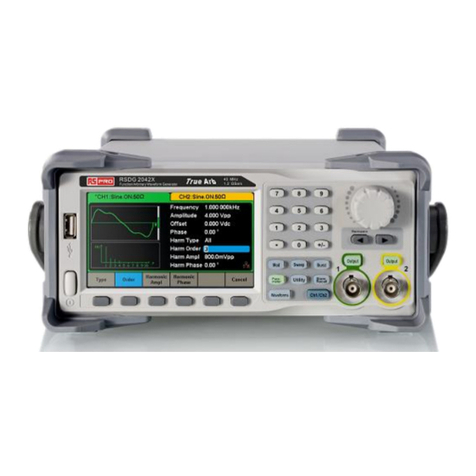
RS PRO
RS PRO RSDG2000X quick start

Lea
Lea LE75069-83 Original instructions
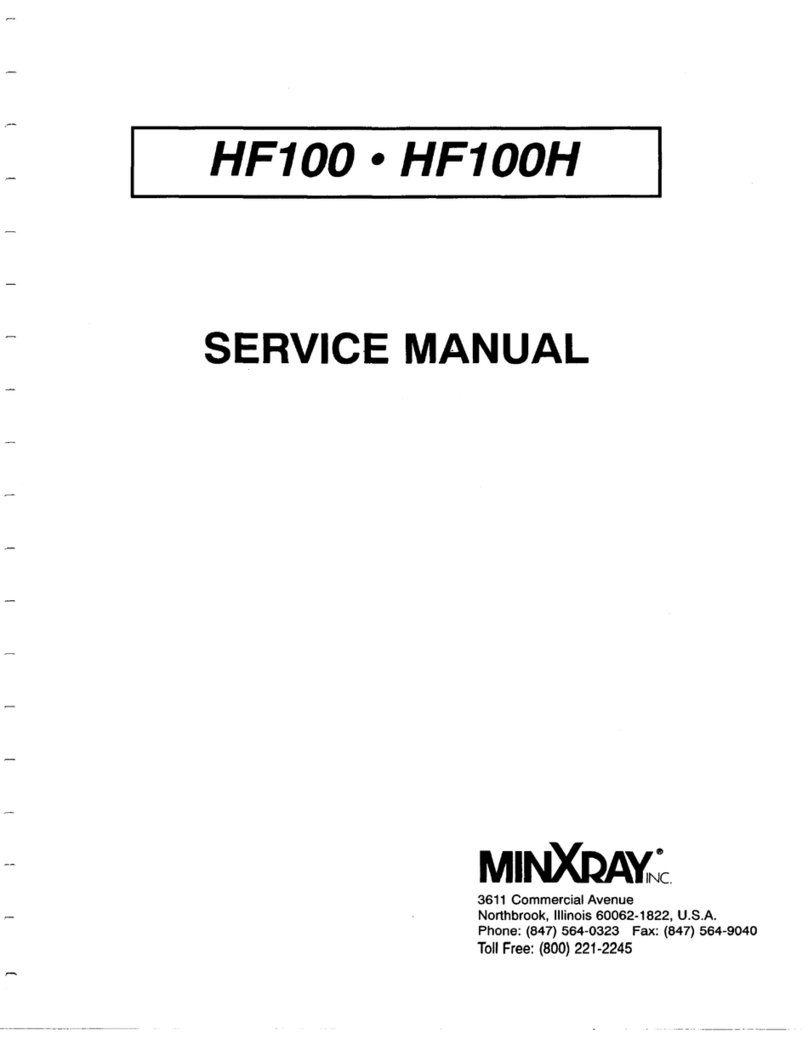
MinXray
MinXray HF100 Service manual

Fabco Power
Fabco Power Hydro 400X-6 instruction manual
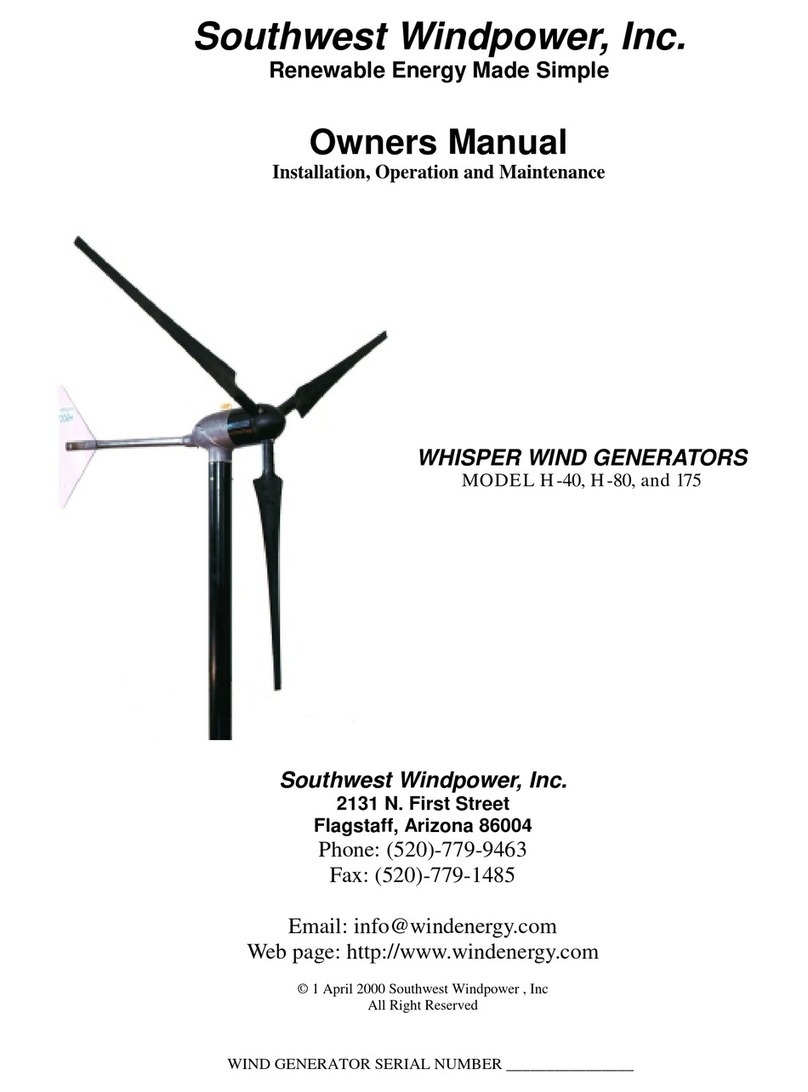
Southwest Windpower
Southwest Windpower H40 owner's manual

Porter-Cable
Porter-Cable H1000IS-W instruction manual
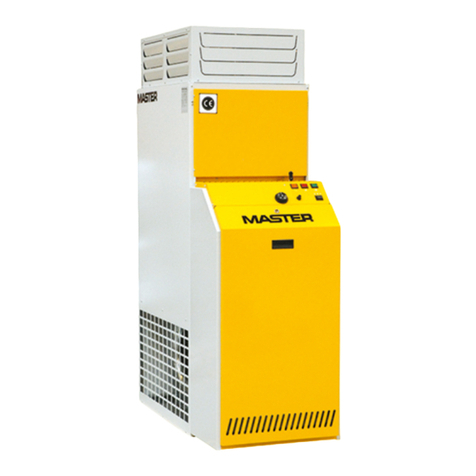
Dantherm
Dantherm Master BF Series Installation and operation
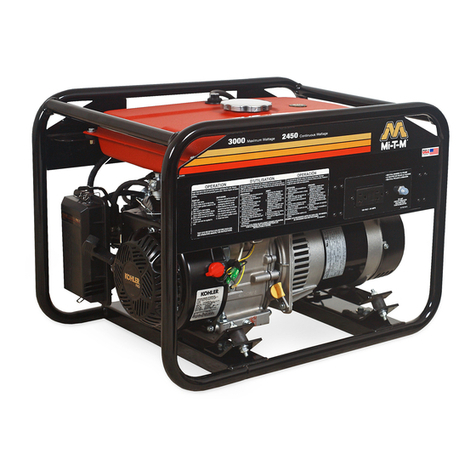
Mi-T-M
Mi-T-M GEN-3000-1LKO Operator's manual
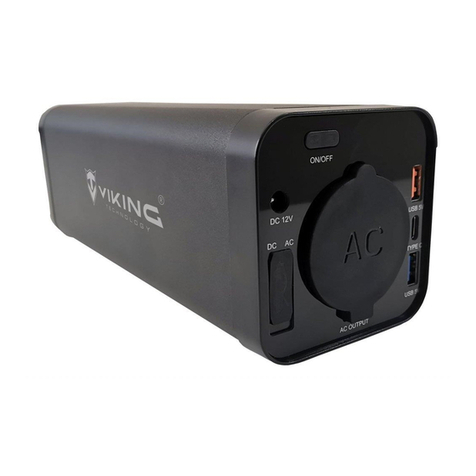
Viking Technology
Viking Technology UP200 user manual
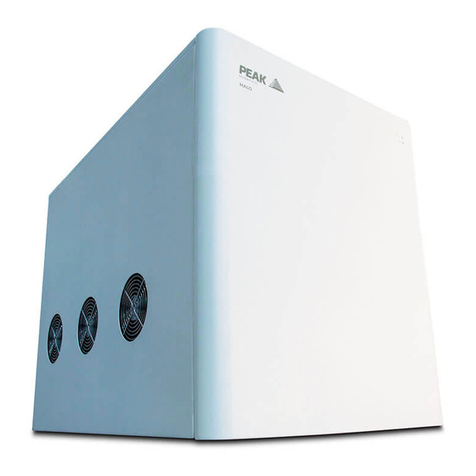
Peak Scientific
Peak Scientific Halo Service manual

Energizer
Energizer HardCase Professional EVEREST 300 user guide
